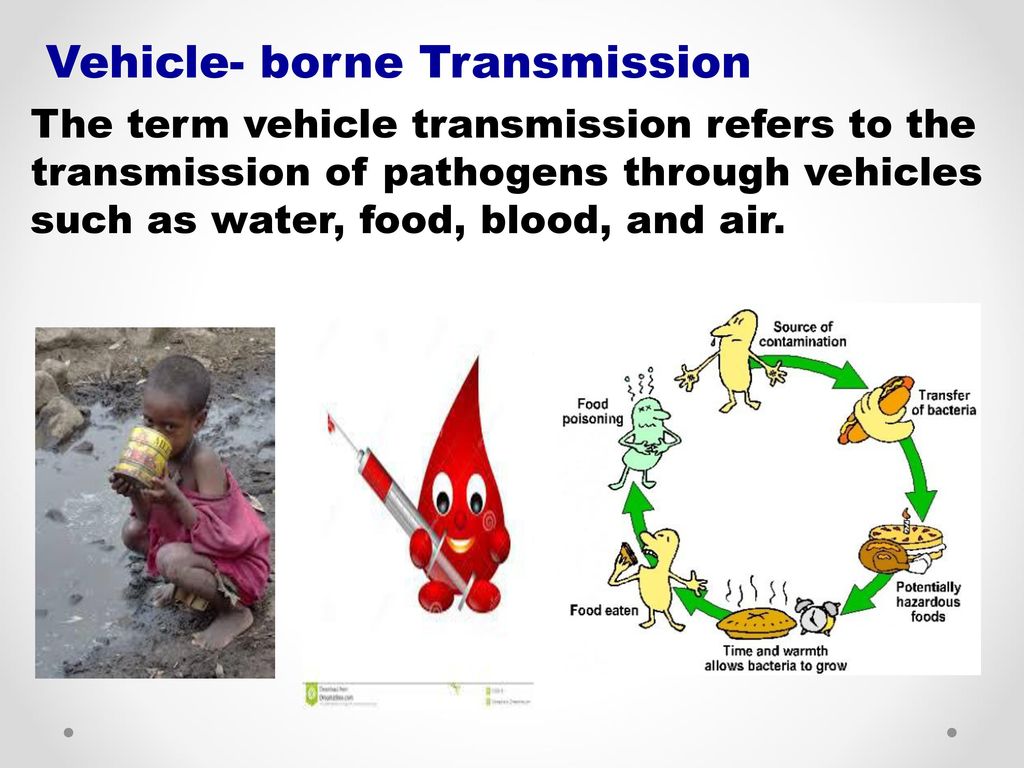Once an infectious agent leaves a reservoir, it must get transmitted to a new host if it is to multiply and cause disease. The route by which an infectious agent is transmitted from a reservoir to another host is called the mode of transmission. It is important for you to identify different modes of transmission, because prevention and control measures differ depending on the type. Various direct and indirect modes of transmission are summarised in the table below and discussed below it.
- Modes Of Transmission Of Disease
- Vehicle Borne Transmission Examples
- Vehicle-borne Transmission Of Disease
This mode of transmission would be considered direct contact rather than common vehicle transmission. The fecal-oral route can transmit diseases caused by bacteria, viruses, or protozoa. Roll over the tabs to see some of the infectious agents in each of these categories. Noun: vehicle-borne transmission. Indirect transmission of an infectious agent that occurs when a vehicle (or fomite) touches a person's body or is ingested. Derived forms: vehicle-borne transmissions. Type of: indirect transmission. Vehicle Transmission: According to Park vehicle transmission implies transmission of the disease agent through the agency of water, ice, milk, food, serum, plasma or other biological products, of these, water is most important vehicle of transmission in many areas of the world because it is used by every one.
Summary of different modes of transmission.
| Mode of transmission | Sub-types of transmission |
|---|---|
| Direct | Touching Sexual intercourse Biting Direct projection of droplets Across the placenta |
| Indirect | Airborne Vehicle-borne Vector-borne |
- Vehicle-borne transmission (noun) indirect transmission of an infectious agent that occurs when a vehicle (or fomite) touches a person's body or is ingested How to.
- Vehicle-borne transmission related to fomites, food, or water that acts as a conveyance (i.e. HIV/AIDS spread through needle sharing drug users) Fomite-borne transmission.
Direct modes of transmission
Direct transmission refers to the transfer of an infectious agent from an infected host to a new host, without the need for intermediates such as air, food, water or other animals. Direct modes of transmission can occur in two main ways:

- Person to person: The infectious agent is spread by direct contact between people through touching, biting, kissing, sexual intercourse or direct projection of respiratory droplets into another person's nose or mouth during coughing, sneezing or talking. A familiar example is the transmission of HIV from an infected person to others through sexual intercourse.
- Transplacental transmission: This refers to the transmission of an infectious agent from a pregnant woman to her fetus through the placenta. An example is mother-to-child transmission (MTCT) of HIV.
Indirect modes of transmission
Modes Of Transmission Of Disease
Indirect transmission is when infectious agents are transmitted to new hosts through intermediates such as air, food, water, objects or substances in the environment, or other animals. Indirect transmission has three subtypes:
- Airborne transmission: The infectious agent may be transmitted in dried secretions from the respiratory tract, which can remain suspended in the air for some time. For example, the infectious agent causing tuberculosis can enter a new host through airborne transmission.
- Vehicle-borne transmission: A vehicle is any non-living substance or object that can be contaminated by an infectious agent, which then transmits it to a new host. Contamination refers to the presence of an infectious agent in or on the vehicle.
- Vector-borne transmission: A vector is an organism, usually an arthropod, which transmits an infectious agent to a new host. Arthropods which act as vectors include houseflies, mosquitoes, lice and ticks.
Arthropods are invertebrates (animals without backbones), such as insects, which have segmented bodies and three pairs of jointed legs.
Can you suggest some examples of vehicles that could transmit specific infectious agents indirectly to new hosts?
You may have thought of some of the following:
- Contaminated food, water, milk, or eating and drinking utensils. For example, the infectious agent of cholera can be transmitted to a person who eats food or drinks water contaminated with faeces containing the organism.
- Contaminated objects such as towels, clothes, syringes, needles and other sharp instruments. For example, sharp instruments contaminated with HIV-infected blood can transmit HIV if they penetrate the skin of another person.
- Soil is a vehicle for some bacteria. For example, a person can be infected with bacteria that cause tetanus if contaminated soil gets in through broken skin.
Can you think of a vector-borne disease mentioned several times in this study session?
Download flash card driver. Malaria is transmitted by mosquito vectors.
| 1. Vehicle-borne Transmission Related Terms:Direct Transmission, Indirect Transmission, Vehicle-borne Transmission, Vector-borne Transmission, Airborne Transmission
|
Vehicle Borne Transmission Examples
2. Vehicle-borne transmission is a vehicle that is, an inanimate object or material called in scientific terms a 'fomite'—becomes contaminated with the infectious agent. The agent, such as a virus, may or may not have multiplied or developed in or on the vehicle. The vehicle contacts the person's body.
Notes: It may be ingested (eaten or drunk), touch the skin, or be introduced internally during surgery or medical treatment. Examples of vehicles that can transmit diseases include cooking or eating utensils, bedding or clothing, toys, surgical or medical instruments (like catheters) or dressings. Water, food, drinks (like milk) and biological products like blood, serum, plasma, tissues or organs can also be vehicles.
(Source: Centers for Disease Control and Prevention)
Vehicle-borne Transmission Of Disease
